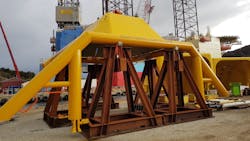Most new Norwegian offshore projects in recent years have come through close to budget, according to the Norwegian Petroleum Directorate. The NPD’s review of 66 projects between 2007 and 2018 found that for just over 80%, costs ended up within or below the 20% uncertainty range cited in the plans for development and operation (PDOs). Cost control proved easier with subsea tiebacks, with 90% completed in line with or below the PDO estimate. Platform-based developments were less successful: while 70% were within the estimated cost range, others incurred cost overruns. Typically, project completion dates were around 3.5 months longer than planned, the report added, with delays generally greater for platform developments. On the plus side, the general shake-up of the industry since the previous oil price slump of 2014 brought improvements in supply chain resources and capacity.
OKEA has confirmed that the Yme redevelopment project in the Norwegian North Sea remains on schedule for first oil in the second half of 2020. The company said it was working with operator Repsol and the other partners to mitigate the impact that travel and other restrictions caused by the COVID-19 virus may have on the project.
Premier winds down Huntington
Premier Oil expected to lift the final cargo this month of oil from the Huntington field in the UK central North Sea, and has submitted a draft decommissioning plan for removal of the Sevan-designed circular FPSO. Since the company became operator in 2016 through acquiring the original developer, E.ON E&P UK, Premier has managed the reservoir to help defer cessation of production.
Last year the company also trialled Ocean Power Technologies’ (OPT) PB3 PowerBuoy at the field. The equipment proved its ability to harness wave energy to power site monitoring systems designed to protect the subsea infrastructure following the departure of the FPSO. Premier said it would continue working with OPT and the Oil & Gas Technology Centre in Aberdeen to further develop the PowerBuoy for other decommissioning programs.
Northern Lights well confirms CO2 goals
Equinor has completed three successful exploration/appraisal wells in the Norwegian North Sea for different purposes. The two wells drilled by the semisub West Phoenix 11 km (6.8 mi) southeast of the Gudrun field proved oil in the Sigrun East prospect - recoverable resources could be up to 17 MMboe. Both wells were a follow- up to appraisal drilling on the Sigrun discovery in 2018, with Equinor seeking to clarify to clarify the commerciality of the area.
The 31/5-7 Eos well south of the Troll field was drilled 2,500 m (8,202 ft) subsurface to assess the suitability of the reservoir in the Johansen formation for storing CO2 (carbon dioxide) as part of the ‘Northern Lights’ project (co-supported by Shell and Total). Early analysis of the data was encouraging, according to Geir Tungesvik, Equinor’s SVP for Project Development, with Eos proving the presence of a sealing shale layer and good-quality reservoir sandstone. This was the first well on exploitation license 001: an investment decision could follow this spring, and if the project progresses to a development, the well will be retained for injection and storage of CO2.
OGA urges lower carbon step-up
UK North Sea companies are playing their part in delivering a low-carbon future, said Andy Samuel, chief executive of the Oil & Gas Authority (OGA) at the recent IP Week 2020 conference in London. “I’m encouraged by what’s happening in the North Sea, but I think we can go a lot quicker,” he suggested. While the North Sea operators Samuel had consulted were “all doing something, none were top quartile,” he said. “We have to level up performance throughout the industry, and that means finding out who is doing best on reducing flaring and the intensity of carbon emissions from production platforms, [offshore] electrification, and carbon capture storage.”
The OGA’s data shows the UK North Sea has cut its emissions by 13% since 2014, he continued. “But we also need to get after electrification of facilities west of Shetland and in the Outer Moray Firth.” Samuel added that the UK offshore had abundant reservoirs and aquifers potentially suited to carbon capture and storage (CCS), and the OGA was tracking 61 potential sites in the North and East Irish Seas. “CCS is also an enabler for blue hydrogen…but let’s get on with it.”
JOG to head Buchan area study
Various operators of discoveries in the Greater Buchan Area in the UK North Sea have agreed that Jersey Oil & Gas should lead a joint integrated studies agreement assessing the technical and commercial requirements for a collaborative development of the area, which holds proven oil and gas resources of over 200 MMboe. One goal is to determine whether collaboration could cut development costs for all concerned in a new production hub, potentially supported by electrification measures. The main fields in the Greater Buchan Area are Buchan, J2, Glenn, Verbier, Avalon, and Leverett. •
About the Author
Jeremy Beckman
Editor, Europe
Jeremy Beckman has been Editor Europe, Offshore since 1992. Prior to joining Offshore he was a freelance journalist for eight years, working for a variety of electronics, computing and scientific journals in the UK. He regularly writes news columns on trends and events both in the NW Europe offshore region and globally. He also writes features on developments and technology in exploration and production.

